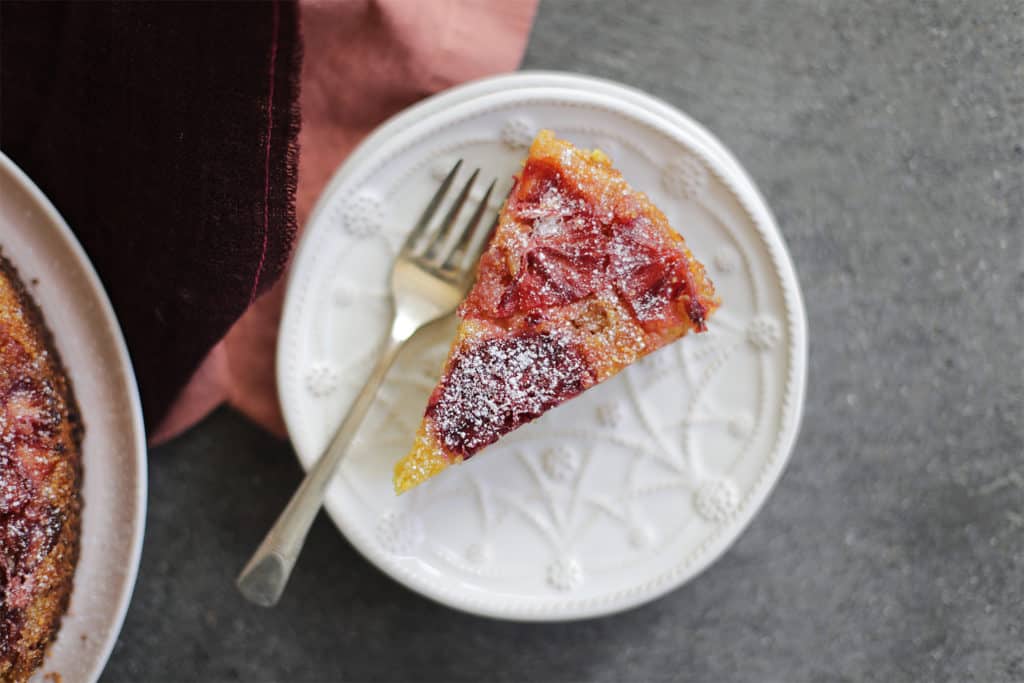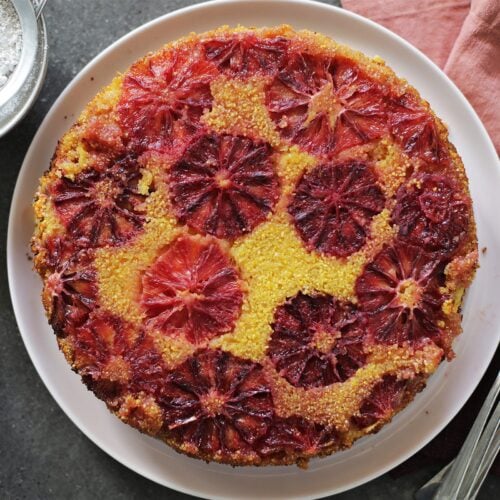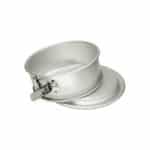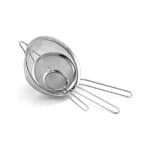We usually bake this Blood Orange Olive Oil Polenta Cake Recipe during winter because blood oranges are at their peak, but you can bake this cake at any time of the year if you want. We bet you got olive oil and polenta all year long anyway, right?

Why You’ll Love This Recipe
You can think of this blood orange polenta cake as comfort food, because you can have it for breakfast, or on a coffee break, or as dessert. Why? Because is light, is fresh, is healthy, and is perfectly sweet.
Recipe Ingredients
These are the ingredients you need to make this recipe:
For The Cake Batter:
- Almond flour – This keeps the moisture in the cake while making it gluten-free and giving a slight nutty flavor.
- Stoneground polenta – Use a good quality, coarse-ground polenta or cornmeal for good texture.
- Baking powder and eggs – To help things rise!
- Kosher salt – To bring out all the flavors
- Granulated sugar – For some sweetness and a tender crumb.
- Pure vanilla extract – To give it a nice floral note.
For The Blood Orange Olive Oil:
- Blood oranges – If you can’t find them, mandarins or Cara Cara oranges will work too.
- Extra-virgin olive oil – I like using something fruity with a distinct flavor.
For Garnish:
- Powdered sugar – For a nice last bit of sweetness
- Ground cardamom – Don’t skip this as it makes the cake elegant!

How To Make This Recipe
These are the instructions to make this recipe:
- Prepare the Pan: Heat the oven to 350°F and arrange a rack in the middle. Lightly coat a 9-inch springform cake pan with olive oil. Add a round of parchment paper and cover the top with the oil.
- Combine The Dry Ingredients: Whisk together the almond flour, polenta, baking powder, and salt, and set aside until ready to use.
- Supreme The Oranges: Zest one of the oranges and set the zest aside for later. Cut off the oranges’ ends, making sure you cut past the bitter white pith to expose the fruit. Place the oranges upright, so they are standing on one of the cut ends, then, using a small sharp knife, remove the peel and pith in sections by cutting down from top to bottom and following the curve of the fruit. Slice three of the oranges into 1/4-inch thick slices and set them aside.
- Make the Blood Orange Olive Oil: Place one whole orange in a food processor or blender along with the remaining cup of extra virgin olive oil and blend until the mixture is very smooth, for about 1 minute.
- Beat the Eggs and Sugar: Meanwhile, combine the eggs and the remaining cup of sugar in a stand mixer fitted with a paddle attachment and beat over medium speed until the mixture is light yellow and airy, about 5 minutes.
- Add The Olive Oil: Turn the mixer to second to the lowest setting and add the vanilla extract and the reserved orange zest, then pour in the olive oil mixture until it’s just mixed in.
- Add the Dry Ingredients: Turn the mixer to its lowest setting and sprinkle in the dry ingredients in four additions until they’re just combined. Make sure you don’t over mix at this point the eggs will lose their volume, and you’ll have a dense cake.
- Place Oranges In The Pan: Take the reserved orange slices and arrange them at the bottom of the prepared pan, and sprinkle with the remaining three tablespoons of sugar.
- Bake the Cake: Gently tap the batter (still in the mixing bowl!) against the counter to remove any significant air bubbles. Pour the batter into the prepared pan, then place the pan in the oven and bake until the cake is set, the top is dark brown, and a cake tester comes out clean except for a few crumbs, about 55 to 65 minutes.
- Cool and Serve: Set the cake aside on a cooling rack. Run a butter knife or pastry spatula along the edge of the cake to release it from the pan, and let it cool to room temperature before removing it from the pan.
To serve, run a knife around the inside of the springform pan ring one more time, then remove the springform ring. Place a plate on top of the cake, then invert the cake. Remove the spring and parchment paper from the bottom.
Serve as is or topped with a dollop of whipped cream, a sprinkle of powdered sugar mixed with a pinch of cardamom, or a scoop of gelato.

California’s Seasonal Produce
Hang around here long enough, and you probably know that California is not only where we call home but also where we take the inspiration for most of the recipes you find here.
We take a page out of the California playbook, keep things seasonal, and produce forward. No surprise that California is the leading agricultural state in the nation and the sole United States producer of almonds, artichokes, dates, raisin grapes, kiwifruit, olives (ripe), clingstone peaches, pomegranates, sweet rice, clover seed, and walnuts.
That means there is something in season here in the Golden State every season. FYI, check out this list of what’s in season in California to help you track when to eat what. During the winter, we love celebrating the ingredients like nuts, pomegranates, rice, citrus, leafy greens, and olive oil from our weekday recipes to gathering with friends — winter brunches, anyone?

Many food lovers aren’t fans of winter because they think there aren’t as many fresh ingredients to cook. But, living in California, we anticipate winter.
You see, winter is the time of year where some of our favorite locally-grown ingredients — dark greens, fresh olive oil, citrus — are at their peak. And it’s when we can bake this cake on repeat!
Recently, our friends at California Grown invited us on a virtual agriculture tour of California, meaning we traveled (by computer) across the state. Over the day, we met lettuce farmers at the southern border, sweet potato farmers in the Central Valley, dairy farmers and cheesemakers, and learned about tons of local produce.
It made us realize we hadn’t shared this cake, a staple around here. It’s not too sweet with a texture, like if cornbread meets pound cake. We consider it a “snack cake” in the same way that coffee cake is — meaning you could have it with coffee for breakfast, as a snack, or dessert.
What Is Traditional Olive Oil Cake?
But let’s talk about this cake, shall we? You may be interested in the history of olive oil cake if you’re a fellow food history enthusiast. Truth be told, this cake is more Californian in origin than anything.
Even so, this recipe may seem a bit Italian, and you’d be correct to say that as you can find plenty of classic Italian desserts made with olive oil. Also? One of our favorite traditional Italian cakes, which hails from the town of Varese near Milan, is known as amor polenta (love of polenta), and it’s where we drew inspiration for that delicious combination of almonds and polenta.
We don’t know when the first cake made with olive oil and polenta was created, but we know it originated in Italy. And we know that the first version that stopped us in our tracks was the pine nut and rosemary version we were served after a feast at Dario Cecchini’s famed butcher shop.
This recipe is a simplified version of an olive oil and polenta cake, ideal for beginner cake bakers. You could make this whole cake by hand, but it’s faster and even easier with the help of a stand mixer.
Citrus Almond Flour Polenta Cake
This mix of almond flour, polenta, olive oil, and citrus is 100% Californian because it not only uses some of our favorite local products — citrus, olive oil, almonds — but also it’s a sunnier, cheerier riff on the classic.
Did we mention it’s also a gluten-free olive oil cake? Very California of us indeed! Right about now, you may be asking, “What does olive oil cake taste like?” and the answer is it’s a rich, decadent, moist cake that, in keeping with Italian desserts, is just barely sweet. Depending on the type of polenta you use, there might even be a bit of crunch, which, to be honest, we love!
How To Choose The Best California Olive Oil
As you’ve likely noticed, we use A LOT of olive oil around these parts. And, as such, we’ve got opinions. If you’ve read our tips on how to buy and store olive oil, then you know we use extra virgin olive oil 99.9% of the time. When it comes to origin, we often buy it from Italy or our home state of California because they both have very high-quality standards. In fact, for olive oil to get approved as “extra virgin” in California, it must meet precise chemical standards and pass a rigorous sensory panel test. Across California, you’ll find myriad different producers growing various types of olives — over 75 varieties of olives are grown for olive oil here! — but the three main varieties are Arbequina, Arbosana, and Koroneiki.
Essential California Citrus Information
When you call the Golden State your home, sooner or later, you realize you’ve become obsessed with citrus. Yes, you think of Florida for oranges, but California produces 80% of all the fresh citrus in the United States. Lemons are available throughout the year. Still, there’s a flood of citrus in the middle of winter, as everything from kumquats to Meyer lemons to mandarins and various oranges is available.
Tips To Make This Olive Oil Polenta Cake
Even if you don’t consider yourself a baker, this Blood Orange Olive Oil Cake is very doable—I promise! Using olive oil instead of butter means the cake will last for days (assuming you haven’t eaten it all sooner).
Here are a few tips to make your baking adventures even more of a success:
- Use Olio Nuovo If You Can Find It: As always, you’ll want to use the freshest ingredients to make this cake, including olive oil. As you’ve heard Aida gush about in the past, she adores Olio Nuovo, the first olive oil of the harvest, which is an unrefined, super flavorful olive oil that needs to be used within a few months. It can be hard to find, but some of our favorite California olive oil producers, McEvoy Ranch and Frog Hollow Farms, have it for sale in the Fall, just after harvest.
- And Use Extra-Virgin Olive Oil: The best alternative to Olio Nuovo is high-quality extra-virgin olive oil. This cake does not hold back (including in the amount of olive oil), so make sure you get a great one!
- Mix Up The Citrus: We’ve made this cake with a variety of citrus, including mandarins, kumquats, Cara Cara oranges, and blood oranges, and they’re all delicious. Just avoid using a tart grapefruit, as it will overpower the cake.
- Know It Will Be Dark Brown: The top of the cake will be very dark brown when it bakes, but don’t worry about it. As long as it isn’t charred, it’s not a problem because you’ll invert the cake before serving it.
- Don’t Overmix the Batter: Our most significant piece of advice is to avoid overmixing the batter. You’d most likely do this when you mix the eggs and sugar, so work it until the mixture is light yellow and ribbony. The eggs will absorb too much air after that, and the cake may deflate slightly as it cooks.
Get A Personalized Travel Itinerary

Blood Orange Olive Oil Polenta Cake Recipe
Equipment








Ingredients
For The Cake Batter:
- 1 cup almond flour (about 4 ounces)
- 1 cup stoneground polenta (not instant) (about 6 ounces)
- 1 teaspoon baking powder
- 1 teaspoon kosher salt
- 4 large eggs room temperature
- 1 cup granulated sugar plus 3 tablespoons for the pan
- 1 teaspoon pure vanilla extract
For The Blood Orange Olive Oil
- 4 medium blood oranges
- 1 cup extra-virgin olive oil plus more for coating pan (or use baking spray)
For Garnish:
- powdered sugar (optional) for garnish
- ground cardamom (optional) for garnish
Instructions
- Prepare The Pan: Heat the oven to 350°F and arrange a rack in the middle. Use the additional olive oil to coat a 9-inch springform cake pan lightly. Add a round of parchment paper, and then cover the top with the additional olive oil.Combine The Dry Ingredients: Whisk together the 1 cup of almond flour, 1 cup of polenta, the one teaspoon baking powder, and the one teaspoon salt and set aside until ready to use.
- Cut The Oranges: Zest one of the oranges and set the zest aside for later. Cut off the ends of all the oranges, making sure you cut past the bitter white pith to expose the fruit. Place the oranges upright, so they are standing on one of the cut ends, then, using a small sharp knife, remove the peel and pith in sections by cutting down from top to bottom and following the curve of the fruit. Slice three of the oranges into 1/4-inch thick slices and set them aside.Make The Blood Orange Olive Oil: Place the remaining one whole orange in a food processor or blender along with the remaining 1 cup of extra virgin olive oil and blend until the mixture is very smooth, about 1 minute.TIP: Blood orange olive oil can be made up to three days in advance. Store in an airtight container at room temperature until ready to use.
- Beat The Eggs And Sugar: Meanwhile, combine the eggs and the remaining 1 cup of sugar in a stand mixer fitted with a paddle attachment and beat over medium speed until the mixture is light yellow and airy about 5 minutes.Add The Olive Oil: Turn the mixer to second to the lowest setting and add the vanilla extract and the reserved orange zest, then pour in the olive oil mixture until it's just mixed in.Add The Dry Ingredients: Turn the mixer to its lowest setting and sprinkle in the dry ingredients in four additions until they're just combined. Make sure you don't over mix at this point the eggs will lose their volume, and you'll have a dense cake.
- Place Oranges In The Pan: Take the reserved oranges slices and arrange them in the bottom of the prepared pan (you may want to cut some slices into half-moons to fill the edges) and sprinkle with the remaining three tablespoons of sugar.Bake The Cake: Gently tap the batter (in the mixing bowl still!) against the counter to remove any significant air bubbles. Pour the batter into the prepared pan, then place the pan in the oven and bake until the cake is set, the top is dark brown, and a cake tester comes out clean except for a few crumbs, about 55 to 65 minutes.TIP: Cake can be made up to three days in advance. Store in an airtight container at room temperature until ready to use.
- Cool And Serve: Set the cake aside on a cooling rack, run a butter knife or pastry spatula along the edge of the cake to release it from the pan, and let it cool to room temperature before removing it from the pan. To serve, run a knife around the inside of the springform pan ring one more time, then remove the springform ring. Place a plate on top of the cake, then invert the cake. Remove the spring from the bottom and the parchment paper. Serve as is or topped with a dollop of whipped cream, a sprinkle of powdered sugar mixed with a pinch of cardamom, or a scoop of gelato.